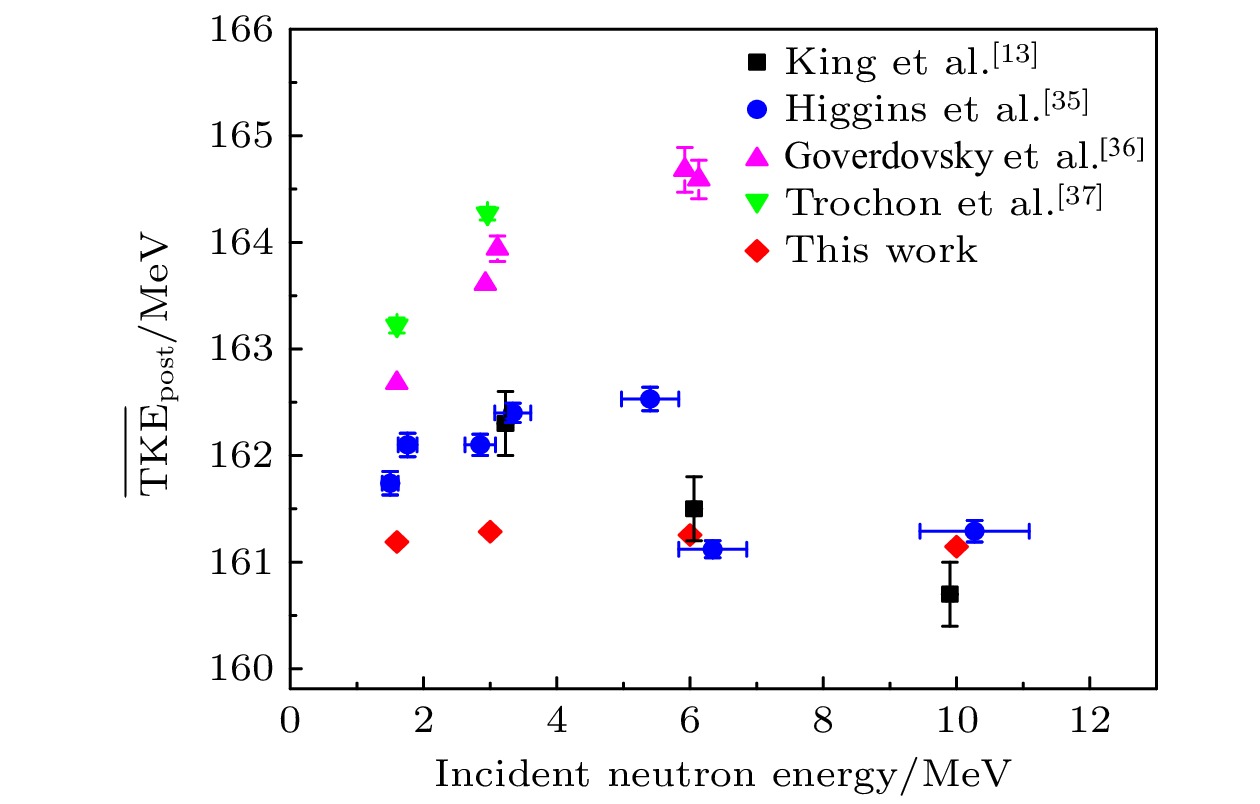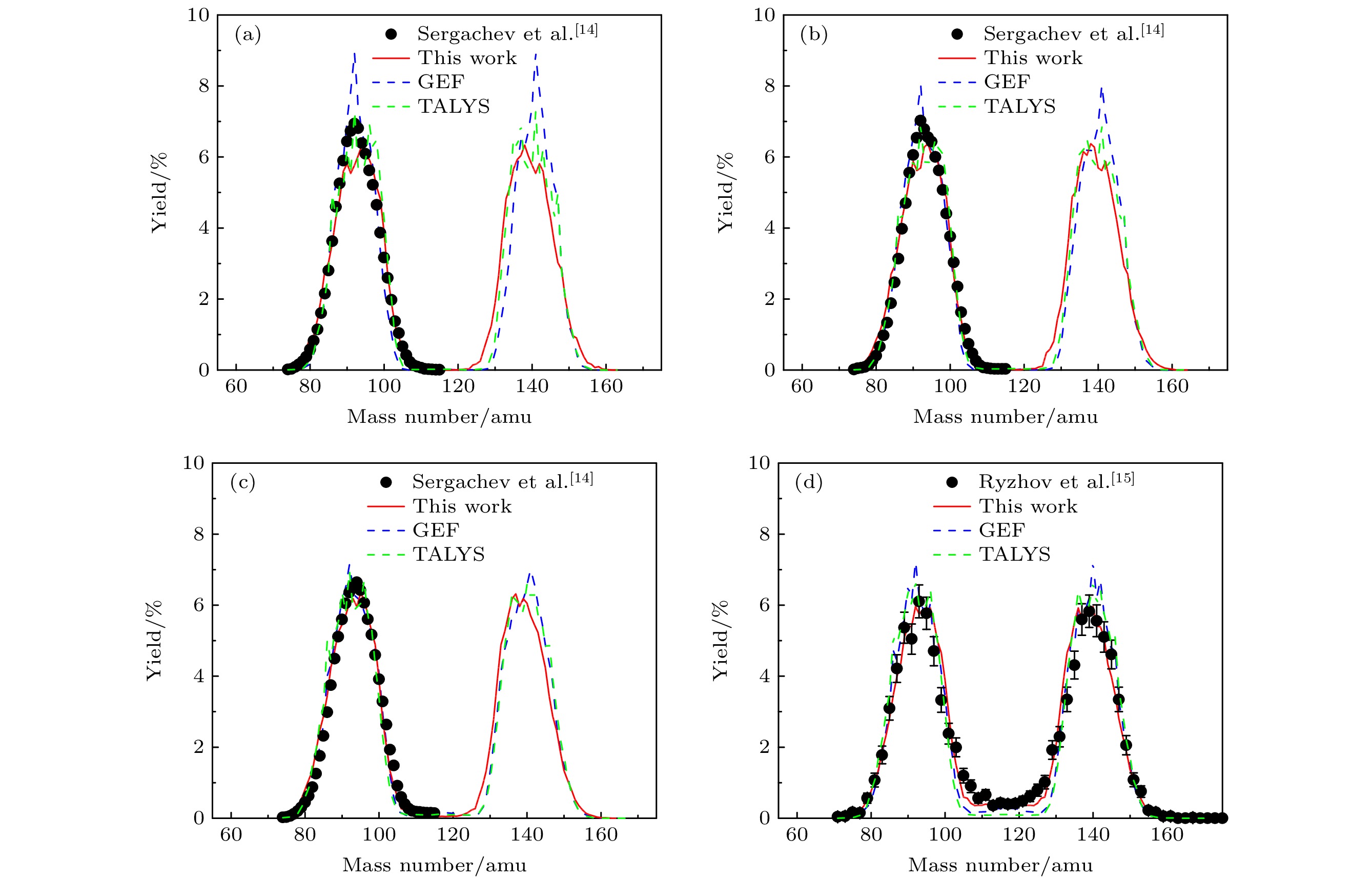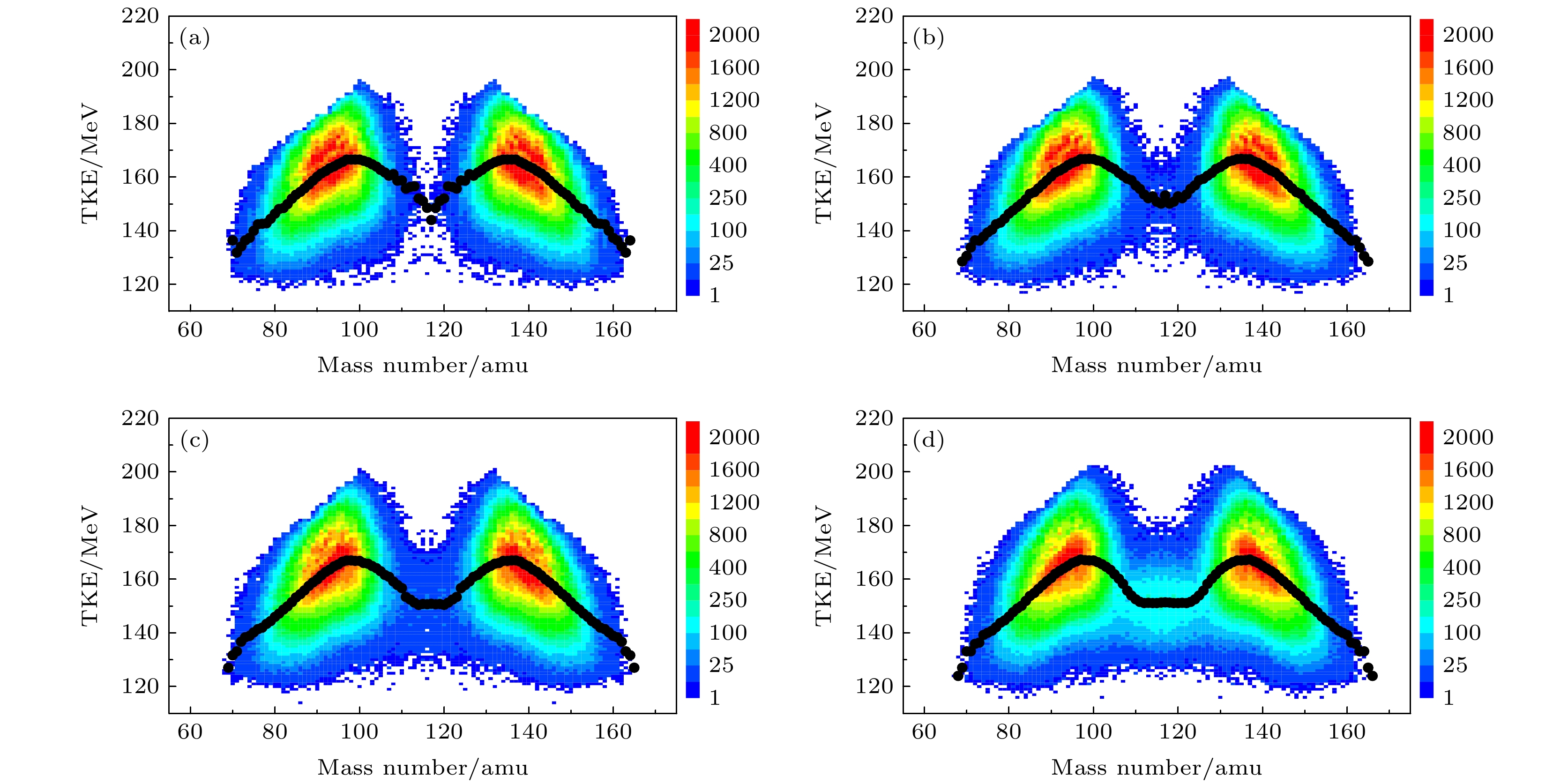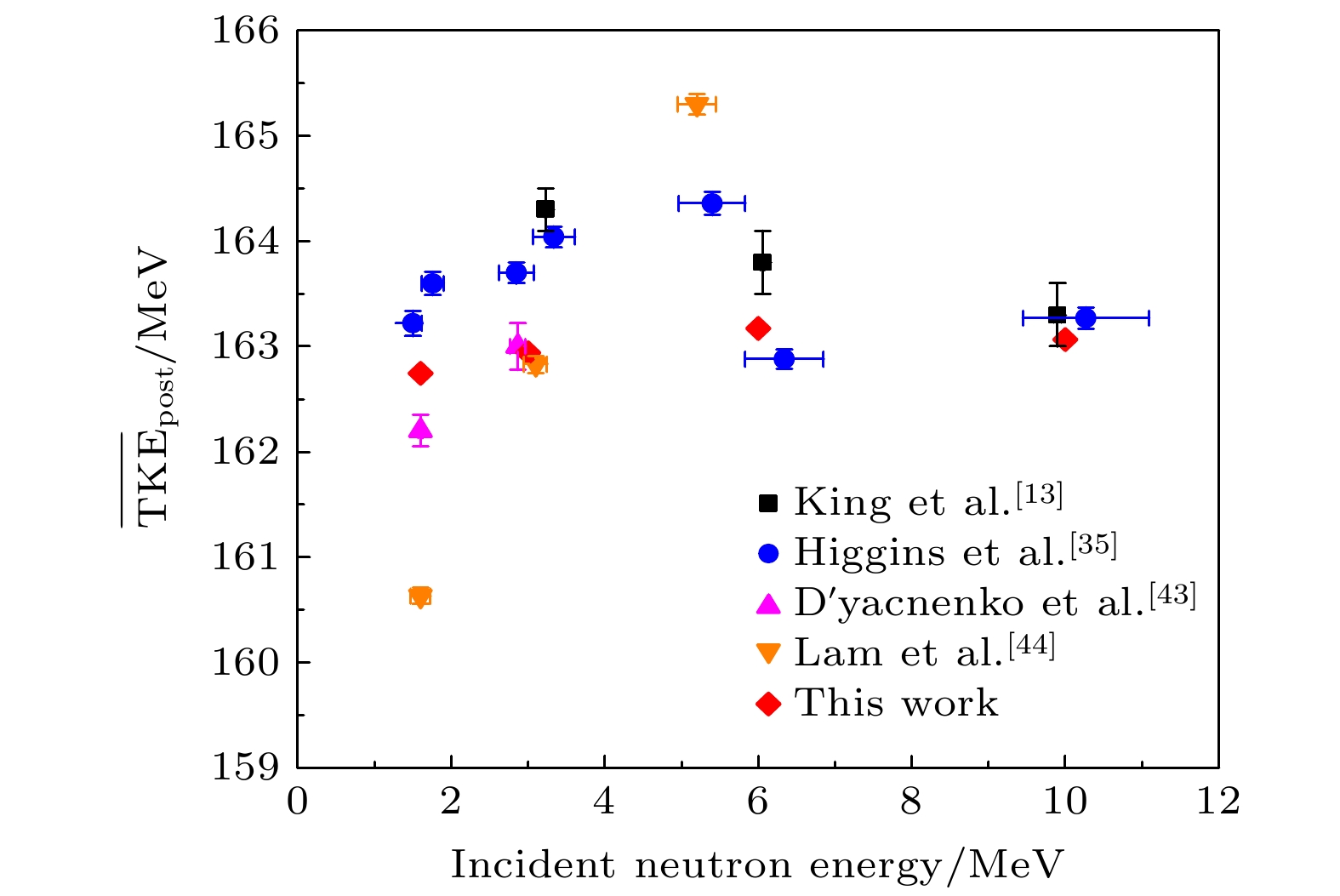-
The development of fourth-generation reactors and advanced nuclear energy systems require high-precision, multi-nuclide, and wide-energy-area neutron nuclear data. However, the current nuclear energy-related nuclear fission data in the China Nuclear Data Evaluation Library (CENDL library) are incomplete and cannot meet the current need. It is extremely important to establish the reliable calculation methods and tools for the neutron nuclear data. Based on the Monte-Carlo method, a model for calculating the pre-neutron fission fragment is established in this work. The mass and kinetic energy distribution of 232Th(n,f) reaction at the medium- and low- incident neutron energy are studied. The calculations of the mass distribution with the different values of incident energy are compared with the experimental results. The maximum deviation of this work from the experimental data is ~1%, which is advantageous compared with the GEF and TALYS code (maximum deviation from the experimental value is ~2%). The calculation of the pre-neutron fission fragment kinetic energy also shows good agreement with experimental result. The results indicate that this model can well describe and predict the characteristics of pre-neutron fission fragment for 232Th(n,f) reaction at the medium- and low- incident neutron energy. It also provides a new idea for calculating the neutron-induced actinide fission reactions.
-
Keywords:
- pre-neutron emission fission fragments /
- mass distribution /
- total kinetic energy distribution /
- Monte-Carlo method
[1] Talou P, Becker B, Kawano T, Chadwick M B, Danon Y 2011 Phys. Rev. C 83 1509
[2] 张竞上 2003 现代物理知识 01 24
Zhang J S 2003 Mod. Phys. 01 24
[3] Forrest R A 2011 Energy Procedia 7 540
 Google Scholar
Google Scholar
[4] Möller P, Sierk A J 2003 Nature 422 485
[5] Al-Adili A, Hambsch F J, Pomp S, Oberstedt S, Vidali M 2016 Phys. Rev. C 93 34603
 Google Scholar
Google Scholar
[6] Salvador-Castineira P, Brys T, Eykens R, Hambsch F-J, Göök A, Moens A, Oberstedt S, Sibbens G, Vanleeuw D, Vidali M 2015 Phys. Rev. C 92 014620
 Google Scholar
Google Scholar
[7] Meierbachtol K, Tovesson F, Duke D L, Geppert-Kleinrath V, Manning B, Meharchand R, Mosby S, Shields D 2016 Phys. Rev. C 94 034611
 Google Scholar
Google Scholar
[8] 蔡翔舟, 戴志敏, 徐洪杰 2016 物理 45 578
 Google Scholar
Google Scholar
Cai X Z, Dai Z M, Xu H J 2016 Physics 45 578
 Google Scholar
Google Scholar
[9] Crasta R, Naik H, Suryanarayana S V, Shivashankar B S, Mulik V K, Prajapati P M, Sanjeev G, Sharma S C, Bhagwat P V, Mohanty A K, Ganesan S, Goswami A 2012 Ann. Nucl. Energy 47 160
 Google Scholar
Google Scholar
[10] 李光超 2017 博士学位论文 (上海: 中国科学院上海应用物理研究所)
Li G C 2017 Ph. D. Dissertation (Shanghai: Shanghai Institute of Applied Physics, Chinese Academy of Sciences) (in Chinese)
[11] Trochon J, Yehia H A, Brisard F, Pranal Y 1979 Nucl. Phys. A 318 63
 Google Scholar
Google Scholar
[12] Naik H, Mukherji S, Suryanarayana S V, Jagadeesan K C, Thakare S V, Sharma S C 2016 Nucl. Phys. A 952 100
 Google Scholar
Google Scholar
[13] King J, Yanez R, Loveland W, Barrett J S, Oscar B, Fotiades N, Tovesson F, Lee H Y 2017 Eur. Phys. J. A 53 238
 Google Scholar
Google Scholar
[14] Sergachev A I, Vorob'Eva V G, Kuz'Minov B D, Mikhailov V B, Tarasko M Z 1968 Yadern. Fiz. 7 778
[15] Ryzhov I V, Yavshits S G, Tutin G A, Kovalev N V, Saulski A V, Kudryashev N A 2011 Phys. Rev. C 83 054603
 Google Scholar
Google Scholar
[16] 葛智刚, 陈永静 2015 科学通报 60 3087
 Google Scholar
Google Scholar
Ge Z G, Chen Y J 2015 Chin. Sci. bull. 60 3087
 Google Scholar
Google Scholar
[17] Schmidt K H, Jurado B, Amouroux C 2016 Nucl. Data Sheets 131 107
 Google Scholar
Google Scholar
[18] Koning A J, Hilaire S, Duijvestijn M C 2007 Proceedings of the International Conference on Nuclear Data for Science and Technology Nice, France, April 22–27, 2007 pp1–214
[19] 郝艺伟, 董国香, 王小保 2019 中国科学: 物理学 力学 天文学 49 122001
Hao Y W, Dong G X, Wang X B 2019 Scientia Sinica Physica, Mechanica & Astronomica 49 122001
[20] Brosa U 1985 Phys. Rev. C 32 1438
 Google Scholar
Google Scholar
[21] Brosa U, Grossmann S, Muller A, Becker E 1989 Nucl. Phys. A 502 423c
 Google Scholar
Google Scholar
[22] Hambsch F J, Vivès F, Siegler P, Oberstedt S 2000 Nucl. Phys. A 679 3
 Google Scholar
Google Scholar
[23] Agostinelli S, Allison J, Amako K, et al. 2003 Nucl. Instrum. Methods A 506 250
 Google Scholar
Google Scholar
[24] Mosby S, Tovesson F, Couture A, Duke D L, et al. 2014 Nucl. Instrum. Methods A 757 75
 Google Scholar
Google Scholar
[25] Vivès F, Hambsch F J, Bax H, Oberstedt S 2000 Nucl. Phys. A 662 63
 Google Scholar
Google Scholar
[26] Zeynalova O V, Zeynalov S, Hambsch F J, Oberstedt S, Fabry I 2010 Bull. Russ. Acad. Sci. Phys. 74 800
 Google Scholar
Google Scholar
[27] Chadwick M B, Herman M, Obložinský P, et al. 2011 Nucl. Data Sheets 112 2887
 Google Scholar
Google Scholar
[28] Liu C Q, Hu Z M, Hu Z J, et al. 2021 J. Instrum. 16 P07038
 Google Scholar
Google Scholar
[29] Wang D, Zhang C, Zhang J H 2015 Radiat. Meas. 73 46
 Google Scholar
Google Scholar
[30] Liu C Q, Wei Z, Han C, et al. 2019 Chin. Phys. C 43 064001
 Google Scholar
Google Scholar
[31] Wei Z, Yao Z E, Lan C L, et al. 2015 J Radioanal. Nucl. Chem. 305 455
 Google Scholar
Google Scholar
[32] Lan C L, Peng M, Zhang Y, Wei Z, Yao Z E, Xie B L 2017 Nucl. Sci. Technol. 28 8
 Google Scholar
Google Scholar
[33] Duke D L, Tovesson F, Laptev A B, Mosby S 2016 Phys. Rev. C 94 054604
 Google Scholar
Google Scholar
[34] Al-Adili A, Hambsch F J, Oberstedt S, Pomp S, Zeynalov S H 2010 Nucl. Instrum. Methods A 624 684
 Google Scholar
Google Scholar
[35] Higgins D, Greife U, Tovesson F, Manning B, Mayorov D, Mosby S, Schmitt K 2020 Phys. Rev. C 101 014601
 Google Scholar
Google Scholar
[36] Goverdovsky A A, Kuzminov B D, Mitrofanov V F, Sergachev A I 1997 Phys. At. Nucl. 60 1787
[37] Trochon J, Yehia H A, Brisard F, Pranal Y 1979 Nuclear Physics A 318 63
[38] Stanley L, Whetstone J 1958 Phys. Rev. 114 581
[39] Albertsson M, Carlsson B G, Døssing T, Möller P, Randrup J, Åberg S 2021 Phys. Rev. C 103 014609
 Google Scholar
Google Scholar
[40] Chen Y J, Liu T J 2011 Chin. Phys. C 35 344
 Google Scholar
Google Scholar
[41] Göök A, Hambscha F J, Oberstedta S, Vidalia M 2015 Physics Procedia 64 190
 Google Scholar
Google Scholar
[42] Schmidt K H, Jurado B 2010 Phys. Rev. Lett. 104 242501
[43] Dyachenko N P, Kuzminov B D, Mitrofanov V F, Sergachev A I 1977 Yadern. Fiz. 26 691
[44] Lam S T, Yu L L, Fielding H W, Dawson W K, Neilson G C 1983 Phys. Rev. C 28 1212
 Google Scholar
Google Scholar
-
图 1 Geant4几何模型示意图. 灰色区域代表锕系核素样品(Sample), 黄色区域代表衬底(Backing). 面向入射中子一侧为样品侧(Sample side), 远离入射中子一侧为衬底侧(Backing side). FF1和FF2分别代表一对互补裂变碎片, 并且它们穿出靶的角度分别为θ1和θ2
Figure 1. Schematic illustration of the Geant4 geometric model. The gray layer is the fissile sample of the actinide target, while the yellow one is the backing support for the sample. The sample side faced the impinging neutrons. FF1 and FF2 respectively denote the fragments emitted from the different sides. θ1 and θ2 are the angles of the fragment axis relative to the axial direction of the incoming neutron.
图 2 发射中子后裂变碎片初始动能
$ {E^{{\text{post}}}} $ 与碎片出射方向相对中子入射方向夹角的余弦值$ \cos \theta $ 的关系 (a) 碎片从样品侧穿出时计算结果; (b) 碎片从衬底侧穿出时计算结果Figure 2.
$ \cos \theta $ versus post-neutron emission kinetic energy$ {E^{{\text{post}}}} $ distribution: (a) The case of the fission fragments from sample side; (b) in the case of the fission fragments from backing side.图 3 232Th(n, f)反应发射中子后TKE分布 (a)中子能量为3 MeV; (b)中子能量为6 MeV; (c)中子能量为10 MeV. 黑线为实验数据[13]; 红线为本文计算数据
Figure 3. Post-neutron emission TKE distribution for 232Th(n, f) reaction: (a) En = 3 MeV; (b) En = 6 MeV; (c) En = 10 MeV. The black line denotes experimental data [13]. The red line denotes the calculated result from this work.
图 4 232Th(n, f)反应发射中子后平均总动能
$ {\overline {{\text{TKE}}} _{{\text{post}}}} $ 随入射中子能量的变化情况. 红点为本文计算数据, 其他颜色点为实验数据[13,35-37]Figure 4. Relationship between the incident neutron energy and
$ {\overline {{\text{TKE}}} _{{\text{post}}}} $ for 232Th(n, f) reaction. The red dots denote the calculated results from this work. The dots with other colors denote the experimental data 13,35-37].图 7 232Th(n, f)反应发射中子前裂变碎片质量分布 (a)中子能量为1.6 MeV; (b)中子能量为3 MeV; (c)中子能量为6 MeV; (d)中子能量为10 MeV. 黑色实心点代表实验结果[14,15], 红线为本工作结果, 蓝线为GEF结果, 绿线为TALYS结果
Figure 7. Calculation of the pre-neutron mass distribution for 232Th(n, f) reaction: (a) En = 1.6 MeV; (b) En = 3 MeV; (c) En = 6 MeV; (d) En = 10 MeV. The black dots line is experimental data [14,15]. The red line is the calculated data from this work, while the blue one is from the GEF code and the green one is from the TALYS code.
图 8 232Th(n, f)反应质量分布计算与实验结果偏差分析 (a)中子能量为1.6 MeV; (b)中子能量为3 MeV; (c)中子能量为6 MeV; (d)中子能量为10 MeV. 红线为本工作结果, 蓝线为GEF结果, 绿线为TALYS结果
Figure 8. Difference of the mass distribution between calculation and experimental data for 232Th(n, f) reaction: (a) En = 1.6 MeV; (b) En = 3 MeV; (c) En = 6 MeV; (d) En = 10 MeV. The red line is the calculated data from this work, while the blue one is from the GEF code and the green one is from the TALYS code.
图 9 发射中子前裂变碎片质量-TKE的二维分布 (a)中子能量为1.6 MeV; (b)中子能量为3 MeV; (c)中子能量为6 MeV; (d)中子能量为10 MeV. 黑点表示碎片质量与平均总动能
$ {\overline {{\text{TKE}}} _{{\text{pre}}}}({m^{{\text{pre}}}}) $ 关系. 图例中颜色标度反映了事件数目Figure 9. Two-dimension distribution of pre-neutron mass versus TKE: (a) En = 1.6 MeV; (b) En = 3 MeV; (c) En = 6 MeV; (d) En = 10 MeV. The black dots denote
$ {\overline {{\text{TKE}}} _{{\text{pre}}}}({m^{{\text{pre}}}}) $ , the relationship between pre-neutron mass and average TKE. The color scale refers to the number of events.图 10 232Th(n, f)反应发射中子前平均总动能
$ {\overline {{\text{TKE}}} _{{\text{pre}}}} $ 随入射中子能量变化情况. 红点为本文计算数据, 其他颜色点为实验数据[13,35,43,44]Figure 10. Relationship between the incident neutron energy and
$ {\overline {{\text{TKE}}} _{{\text{pre}}}} $ for 232Th(n, f) reaction. The red dots denote the calculated results from this work. The dots with other colors denote the experimental data 13,35,43,44]. -
[1] Talou P, Becker B, Kawano T, Chadwick M B, Danon Y 2011 Phys. Rev. C 83 1509
[2] 张竞上 2003 现代物理知识 01 24
Zhang J S 2003 Mod. Phys. 01 24
[3] Forrest R A 2011 Energy Procedia 7 540
 Google Scholar
Google Scholar
[4] Möller P, Sierk A J 2003 Nature 422 485
[5] Al-Adili A, Hambsch F J, Pomp S, Oberstedt S, Vidali M 2016 Phys. Rev. C 93 34603
 Google Scholar
Google Scholar
[6] Salvador-Castineira P, Brys T, Eykens R, Hambsch F-J, Göök A, Moens A, Oberstedt S, Sibbens G, Vanleeuw D, Vidali M 2015 Phys. Rev. C 92 014620
 Google Scholar
Google Scholar
[7] Meierbachtol K, Tovesson F, Duke D L, Geppert-Kleinrath V, Manning B, Meharchand R, Mosby S, Shields D 2016 Phys. Rev. C 94 034611
 Google Scholar
Google Scholar
[8] 蔡翔舟, 戴志敏, 徐洪杰 2016 物理 45 578
 Google Scholar
Google Scholar
Cai X Z, Dai Z M, Xu H J 2016 Physics 45 578
 Google Scholar
Google Scholar
[9] Crasta R, Naik H, Suryanarayana S V, Shivashankar B S, Mulik V K, Prajapati P M, Sanjeev G, Sharma S C, Bhagwat P V, Mohanty A K, Ganesan S, Goswami A 2012 Ann. Nucl. Energy 47 160
 Google Scholar
Google Scholar
[10] 李光超 2017 博士学位论文 (上海: 中国科学院上海应用物理研究所)
Li G C 2017 Ph. D. Dissertation (Shanghai: Shanghai Institute of Applied Physics, Chinese Academy of Sciences) (in Chinese)
[11] Trochon J, Yehia H A, Brisard F, Pranal Y 1979 Nucl. Phys. A 318 63
 Google Scholar
Google Scholar
[12] Naik H, Mukherji S, Suryanarayana S V, Jagadeesan K C, Thakare S V, Sharma S C 2016 Nucl. Phys. A 952 100
 Google Scholar
Google Scholar
[13] King J, Yanez R, Loveland W, Barrett J S, Oscar B, Fotiades N, Tovesson F, Lee H Y 2017 Eur. Phys. J. A 53 238
 Google Scholar
Google Scholar
[14] Sergachev A I, Vorob'Eva V G, Kuz'Minov B D, Mikhailov V B, Tarasko M Z 1968 Yadern. Fiz. 7 778
[15] Ryzhov I V, Yavshits S G, Tutin G A, Kovalev N V, Saulski A V, Kudryashev N A 2011 Phys. Rev. C 83 054603
 Google Scholar
Google Scholar
[16] 葛智刚, 陈永静 2015 科学通报 60 3087
 Google Scholar
Google Scholar
Ge Z G, Chen Y J 2015 Chin. Sci. bull. 60 3087
 Google Scholar
Google Scholar
[17] Schmidt K H, Jurado B, Amouroux C 2016 Nucl. Data Sheets 131 107
 Google Scholar
Google Scholar
[18] Koning A J, Hilaire S, Duijvestijn M C 2007 Proceedings of the International Conference on Nuclear Data for Science and Technology Nice, France, April 22–27, 2007 pp1–214
[19] 郝艺伟, 董国香, 王小保 2019 中国科学: 物理学 力学 天文学 49 122001
Hao Y W, Dong G X, Wang X B 2019 Scientia Sinica Physica, Mechanica & Astronomica 49 122001
[20] Brosa U 1985 Phys. Rev. C 32 1438
 Google Scholar
Google Scholar
[21] Brosa U, Grossmann S, Muller A, Becker E 1989 Nucl. Phys. A 502 423c
 Google Scholar
Google Scholar
[22] Hambsch F J, Vivès F, Siegler P, Oberstedt S 2000 Nucl. Phys. A 679 3
 Google Scholar
Google Scholar
[23] Agostinelli S, Allison J, Amako K, et al. 2003 Nucl. Instrum. Methods A 506 250
 Google Scholar
Google Scholar
[24] Mosby S, Tovesson F, Couture A, Duke D L, et al. 2014 Nucl. Instrum. Methods A 757 75
 Google Scholar
Google Scholar
[25] Vivès F, Hambsch F J, Bax H, Oberstedt S 2000 Nucl. Phys. A 662 63
 Google Scholar
Google Scholar
[26] Zeynalova O V, Zeynalov S, Hambsch F J, Oberstedt S, Fabry I 2010 Bull. Russ. Acad. Sci. Phys. 74 800
 Google Scholar
Google Scholar
[27] Chadwick M B, Herman M, Obložinský P, et al. 2011 Nucl. Data Sheets 112 2887
 Google Scholar
Google Scholar
[28] Liu C Q, Hu Z M, Hu Z J, et al. 2021 J. Instrum. 16 P07038
 Google Scholar
Google Scholar
[29] Wang D, Zhang C, Zhang J H 2015 Radiat. Meas. 73 46
 Google Scholar
Google Scholar
[30] Liu C Q, Wei Z, Han C, et al. 2019 Chin. Phys. C 43 064001
 Google Scholar
Google Scholar
[31] Wei Z, Yao Z E, Lan C L, et al. 2015 J Radioanal. Nucl. Chem. 305 455
 Google Scholar
Google Scholar
[32] Lan C L, Peng M, Zhang Y, Wei Z, Yao Z E, Xie B L 2017 Nucl. Sci. Technol. 28 8
 Google Scholar
Google Scholar
[33] Duke D L, Tovesson F, Laptev A B, Mosby S 2016 Phys. Rev. C 94 054604
 Google Scholar
Google Scholar
[34] Al-Adili A, Hambsch F J, Oberstedt S, Pomp S, Zeynalov S H 2010 Nucl. Instrum. Methods A 624 684
 Google Scholar
Google Scholar
[35] Higgins D, Greife U, Tovesson F, Manning B, Mayorov D, Mosby S, Schmitt K 2020 Phys. Rev. C 101 014601
 Google Scholar
Google Scholar
[36] Goverdovsky A A, Kuzminov B D, Mitrofanov V F, Sergachev A I 1997 Phys. At. Nucl. 60 1787
[37] Trochon J, Yehia H A, Brisard F, Pranal Y 1979 Nuclear Physics A 318 63
[38] Stanley L, Whetstone J 1958 Phys. Rev. 114 581
[39] Albertsson M, Carlsson B G, Døssing T, Möller P, Randrup J, Åberg S 2021 Phys. Rev. C 103 014609
 Google Scholar
Google Scholar
[40] Chen Y J, Liu T J 2011 Chin. Phys. C 35 344
 Google Scholar
Google Scholar
[41] Göök A, Hambscha F J, Oberstedta S, Vidalia M 2015 Physics Procedia 64 190
 Google Scholar
Google Scholar
[42] Schmidt K H, Jurado B 2010 Phys. Rev. Lett. 104 242501
[43] Dyachenko N P, Kuzminov B D, Mitrofanov V F, Sergachev A I 1977 Yadern. Fiz. 26 691
[44] Lam S T, Yu L L, Fielding H W, Dawson W K, Neilson G C 1983 Phys. Rev. C 28 1212
 Google Scholar
Google Scholar
Catalog
Metrics
- Abstract views: 9892
- PDF Downloads: 166
- Cited By: 0














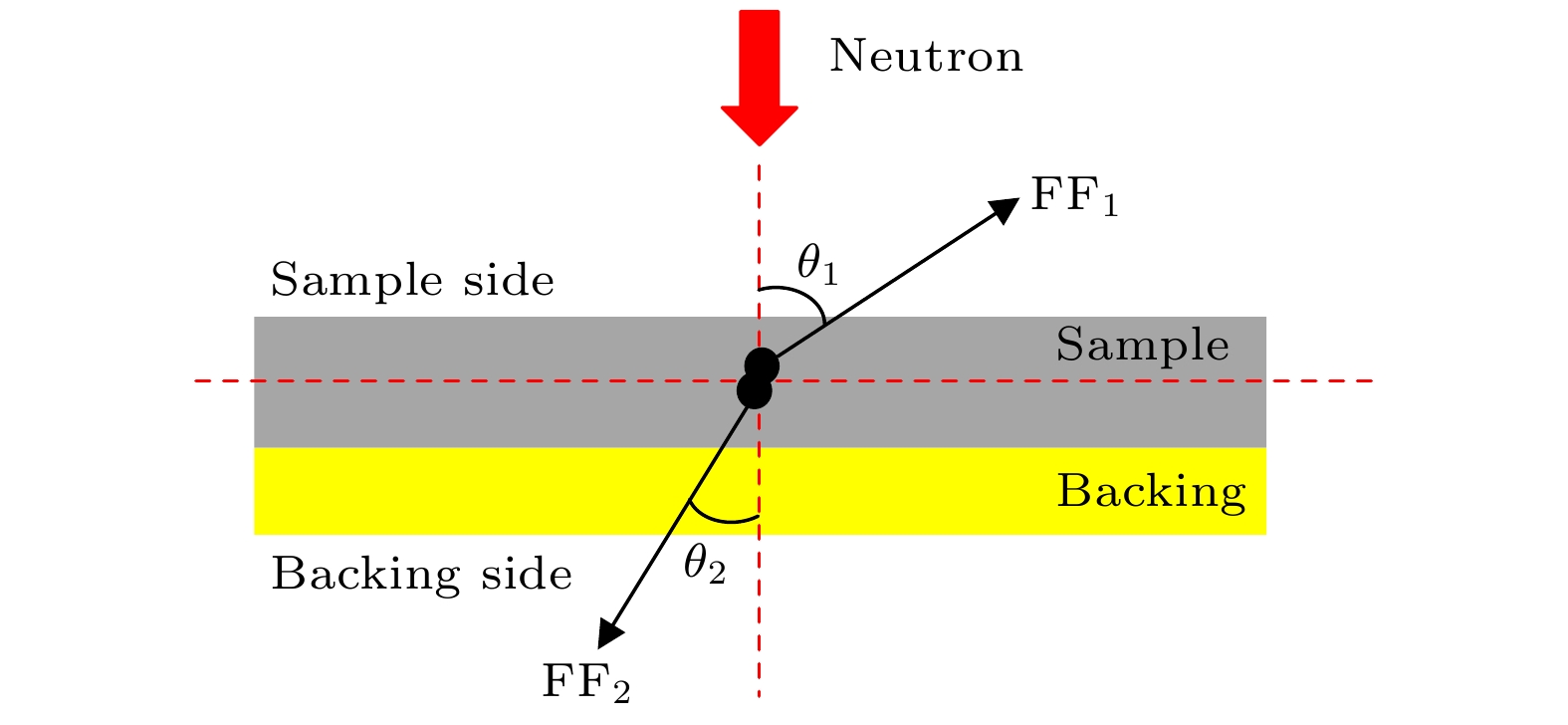
 DownLoad:
DownLoad:






